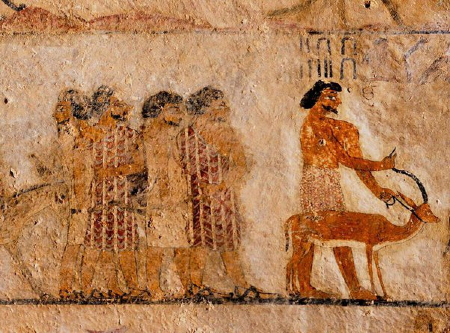 Hi readers, it seems you use Catholic Online a lot; that's great! It's a little awkward to ask, but we need your help. If you have already donated, we sincerely thank you. We're not salespeople, but we depend on donations averaging $14.76 and fewer than 1% of readers give. If you donate just $5.00, the price of your coffee, Catholic Online School could keep thriving. Thank you. Help Now >
Hi readers, it seems you use Catholic Online a lot; that's great! It's a little awkward to ask, but we need your help. If you have already donated, we sincerely thank you. We're not salespeople, but we depend on donations averaging $14.76 and fewer than 1% of readers give. If you donate just $5.00, the price of your coffee, Catholic Online School could keep thriving. Thank you. Help Now >
Levites
FREE Catholic Classes
(From Levi , name of the ancestral patriarch, generally interpreted "joined" or "attached to"--see Genesis 29:34 , also Numbers 18:2, 4 , Hebrew text).
The subordinate ministers appointed in the Mosaic Law for the service of the Tabernacle and of the Temple.
Levi was the third son borne to Jacob by Lia, and full brother of Ruben, Simeon, and Juda. Together with Simeon he avenged the humiliation of their sister Dina by the slaughter of Sichem and his people ( Genesis 34 ), for which deed of violence the two brothers were reproved both in Genesis 34:30 , and in the prophecy attributed to the patriarch in Genesis 49:5-7 .
Waiving all critical discussion connected with this incident as also with the other events connected with the history of the tribe, the next point to be noticed is the connexion of Levi with the priesthood. According to the received Biblical account, all the male descendants of the patriarch were set apart by Moses, acting under Divine command, for the service of the sanctuary, a distinction which may have been due to the religious zeal manifested by the tribe on the occasion of the idolatrous worship of the golden calf ( Exodus 32:25-29 ). As it was also the tribe to which Moses himself belonged, it could probably be relied upon more than the others to sustain the legislator in the establishment and promotion of his religious institutions among the people. The sacred calling of the Levites is mentioned in various passages of the Pentateuch. For instance, the author of the first chapters of Numbers (P), after recalling (iii; cf. Exodus 28:29 ; Leviticus 8:9 ) the names and sacred functions of the sons of Aaron, adds the designation of the entire tribe of Levi who were to "stand in the sight of Aaron the priest to minister to him. And let them watch, and observe whatsoever appertaineth to the service of the multitude before the tabernacle of the testimony, and let them keep the vessels of the tabernacle, serving in the ministry thereof." Though in Numbers 18:23 , the special mission of the tribe is described broadly as a mediation between the Lord and his people, and though the Levite mentioned in the interesting and very ancient passage of Judges ( 17 and 18 ) is represented as exercising without qualification the functions of the priesthood, it is held by many commentators that at an early date a distinction was made between the priests of the family of Aaron and the simple Levites--a distinction which became very pronounced in the later religious history of the Chosen People. The ceremonies with which the simple Levites were consecrated to the service of the Lord are described in Numbers 8:5-22 . Besides their general function of assisting the priests, the Levites were assigned to carry the Tabernacle and its utensils, to keep watch about the sanctuary, etc. As most of their duties required a man's full strength, the Levites did not enter upon their functions before the age of thirty.
In the distribution of the Land of Chanaan after the conquest, Josue, acting according to instructions received from Moses, excluded the tribe of Levi from sharing like the others in the territory. "But to the tribe of Levi he gave no possession: because the Lord the God of Israel himself is their possession" ( Joshua 13:33 ) It way be noted that a very different reason for this exception is mentioned in Genesis 49:5-7 . In lieu of a specified territory, the members of the tribe of Levi received permission to dwell scattered among the other tribes, special provision being made for their maintenance. Besides the tithes of the produce of land and cattle, and other sacerdotal dues already granted by Moses, the Levites now received from each of the other tribes four cities with suburban pasture lands, or forty-eight in all ( Joshua 21 ). Among these were included the six cities of refuge, three on each side of the Jordan, which were set aside to check the barbarous custom of blood revenge, still existing among the Arab tribes, and in virtue of which the kinsmen of a man put to death consider it a duty to avenge him by the killing of his intentional or even unintentional slayer. It is probable, however, that these administrative dispositions concerning the Levites were not fully carried out until some time after the conquest, for, during the long period of transition between the wandering life of the desert and the fully organized civilization of later times, the priests and Levites seem to have had a rather precarious mode of existence. Taking the story of Michas ( Judges 17 ) as illustrative of the condition of the Levitical order during that early period, it would appear that the priestly functionaries were inadequately provided for and had to wander about to secure a livelihood.
The elaborate and highly differentiated organization of the priestly or Levitical system, described with such abundance of detail in the priestly writings of the Old Testament, was doubtless the result of a long process of religious and ritualistic development which attained its fullness in the post-Exilic period. As elsewhere in the history of ancient religions, there appears in the beginnings of Hebrew history a period when no priestly class existed. The functions of the priesthood were performed generally by the head of the family or clan without need of a special sanctuary, and there is abundant evidence to show that for a long time after the death of Moses the priestly office was exercised, not only occasionally, but even permanently, by men of non-Levitical descent. The Deuteronomic legislation insists on the unity of sanctuary, and recognizes the descendents of Levi as the sole legitimate members of the priesthood, but it ignores the sharply defined distinction between priests and simple Levites which appears in the later writings and legislation, for the whole class is constantly referred to as the "levite priests ". This category excludes the purely lay priest who is no longer tolerated, but if any Levite be willing to leave his residence in any part of the land and come to Jerusalem, "He shall minister in the name of the Lord his God, as all his brethren the Levites do, that shall stand at that time before the Lord. He shall receive the same portion of food that the rest do; besides that which is due him in his own city, by succession from his fathers" ( Deuteronomy 18:6-8 ). In the post-Exilic writings the detailed organization and workings of the levitical system then in its full vigour are adequately described, and a certain number of the regulations pertaining thereto are ascribed to King David. Thus, it is to the period of his reign that I Par. refers the introduction of the system of courses whereby the whole sacerdotal body was divided into classes, named after their respective chiefs and presided over by them. They carried out their various functions week by week, their particular duties being determined by lot (cf. Luke 1:5-9 ). We read also that during the reign of David the rest of the Levites, to the number of thirty-eight thousand, ranging from the age of thirty years and upwards receive a special organization ( 1 Chronicles 23 - 26 ). Levites are mentioned only three times in the New Testament ( Luke 10:32 ; John 1:19 ; Acts 4:36 ), and these references throw no light on their status in the time of Christ.
Join the Movement
When you sign up below, you don't just join an email list - you're joining an entire movement for Free world class Catholic education.
-

-
Mysteries of the Rosary
-
St. Faustina Kowalska
-
Litany of the Blessed Virgin Mary
-
Saint of the Day for Wednesday, Oct 4th, 2023
-
Popular Saints
-
St. Francis of Assisi
-
Bible
-
Female / Women Saints
-
7 Morning Prayers you need to get your day started with God
-
Litany of the Blessed Virgin Mary
Biblical Lost Alphabet Traced Back to Ancient Canaanite Civilization
-

What are the Health Benefits of Grass-Fed Beef for Your Body and Mind?
-

Rise Above Poverty is Empowering Children and Families Through Education and Compassion
-
Artists and Leaders Rally to Preserve the Traditional Latin Mass
-
Republicans Demand Answers Over Army Training Slide Labeling Pro-Life Groups as Terrorist Threats
Daily Catholic
 Daily Readings for Wednesday, July 24, 2024
Daily Readings for Wednesday, July 24, 2024 St. John Boste: Saint of the Day for Wednesday, July 24, 2024
St. John Boste: Saint of the Day for Wednesday, July 24, 2024 Prayer for Travelers: Prayer of the Day for Wednesday, July 24, 2024
Prayer for Travelers: Prayer of the Day for Wednesday, July 24, 2024- Daily Readings for Tuesday, July 23, 2024
- St. Bridget of Sweden: Saint of the Day for Tuesday, July 23, 2024
- A Child's Prayer to Mary: Prayer of the Day for Tuesday, July 23, 2024
![]()
Copyright 2024 Catholic Online. All materials contained on this site, whether written, audible or visual are the exclusive property of Catholic Online and are protected under U.S. and International copyright laws, © Copyright 2024 Catholic Online. Any unauthorized use, without prior written consent of Catholic Online is strictly forbidden and prohibited.
Catholic Online is a Project of Your Catholic Voice Foundation, a Not-for-Profit Corporation. Your Catholic Voice Foundation has been granted a recognition of tax exemption under Section 501(c)(3) of the Internal Revenue Code. Federal Tax Identification Number: 81-0596847. Your gift is tax-deductible as allowed by law.










 Daily Readings for Wednesday, July 24, 2024
Daily Readings for Wednesday, July 24, 2024 St. John Boste: Saint of the Day for Wednesday, July 24, 2024
St. John Boste: Saint of the Day for Wednesday, July 24, 2024 Prayer for Travelers: Prayer of the Day for Wednesday, July 24, 2024
Prayer for Travelers: Prayer of the Day for Wednesday, July 24, 2024

